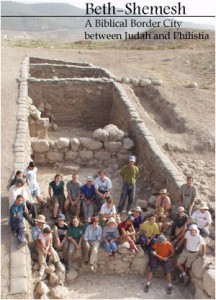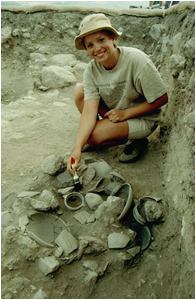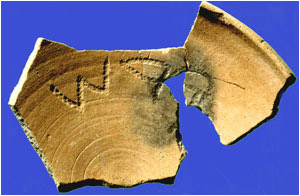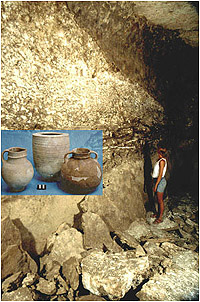Beth-Shemesh
A Biblical Border City between Judah and Philistia
Directors
Prof. Shlomo Bunimovitz
Dr. Zvi Lederman
zvi.lederman@gmail.com

Backround
Tel Beth-Shemesh is an important biblical site in the northeastern Shephelah (lowland) of Judah. The 7-acre mound is located near the modern town of Beth-Shemesh, some 20 km west of Jerusalem, and overlooks the Sorek Valley. Situated at the geographical, political and cultural border, as well as the meeting point between Canaanites, Philistines and Israelites, Beth-Shemesh was the scene of great historical events and cultural changes. It is, therefore, an ideal site for the investigation of key historical and cultural issues relating to the vexed relations and interaction between these three peoples.
The name Beth-Shemesh (“House of the Sun”) is suggestive of the deity that was worshipped by the Canaanite inhabitants of the ancient city. Identification of the mound with biblical Beth-Shemesh is based on its geographical description in the Bible, on Byzantine sources and on the name of the nearby Arab village ‘Ain Shems, which preserved the ancient name.
The Bible mentions Beth-Shemesh in the description of the northern border of the Tribe of Judah (Joshua 15: 10-11) and as a Levitical city in the territory of Judah (Joshua 21: 16). Following the battle of Ebenezer and the capture of the Ark of the Covenant by the Philistines, the ark was
returned to Beth-Shemesh (1 Samuel 6: 9-18). The town is listed in Solomon’s second administrative district (1 Kings 4: 9), and it was here that the battle between Joash, king of Israel, and Amaziah, king of Judah, took place (2 Kings 14: 11-13). Shortly thereafter, Beth-Shemesh passed into Philistine control but was restored to the Kingdom of Judah under Hezekiah (2 Chronicles 28: 18). The town was destroyed by Sennacherib, king of Assyria, during his campaign in Judah, in 701 BCE.
Excavations conducted at Tel Beth-Shemesh in 1911-1912 by D. Mackenzie on behalf of the Palestine Exploration Fund (PEF) and in 1928-1933 by E. Grant from Haverford College, Pennsylvania, exposed large parts of the mound, down to bedrock. Remains of several successive cities from the Bronze and Iron Ages were uncovered. But these excavations, conducted during the early days of archaeology in Israel, left open many important questions concerning the cultural and social history of Beth-Shemesh. The aim of the new excavations initiated in 1990 by Shlomo Bunimovitz and Zvi Lederman of the Institute of Archaeology of Tel Aviv University is to answer these questions. In the course of the past eleven seasons of excavation
(1990-2000) mainly remains from the Iron Age (periods of the Judges and the Israelite Monarchy, 12th-7th centuries BCE) were exposed. In the coming years, the expedition plans to excavate the remains of the Canaanite cities that preceded the Israelite ones.
The Period of the Judges (12th-11th Centuries BCE)
The new excavations at Tel Beth-Shemesh revealed that during the period of the Judges a large village or town spread all over the mound. Remains of a large two-storied structure, probably the house of a well-to-do person, were uncovered on the northern part of the tel. The house has a few spacious rooms, one of them beautifully paved with river pebbles, and a court. Some gold jewellery, fallen from the second floor, was found among the ruins of the house. Next to this building simpler houses --some of whose ceilings were supported by wooden columns on stone bases--were found. Grindstones, clay ovens and hearths attest to the daily activities of their inhabitants. The architecture of the houses, as well as the pottery used by the inhabitants of Beth-Shemesh during this period, is in the Canaanite tradition. But the bones of the animals they consumed attest to a diet typical of the Israelites who occupied the hill country--pigs are entirely absent. These intriguing finds indicate that ethnic affiliation during the 12th-11th centuries BCE, especially on the Philistine border, was still fluid and in a process of structuring.

The Period of the United Monarchy and the Kingdom of Judah (10th-7th Centuries BCE)
In the second half of the 10th century BCE, during the days of the United Monarchy or the beginning of the Kingdom of Judah, the village of Beth-Shemesh was transformed into a regional administrative centre of the kingdom on its border with Philistia. The archaeological remains show evidence of considerable planning and investment in the buildings. An elaborate system of fortifications was discovered on the northeastern side of the tel. The main elements are a piece of a massive wall with a large retaining tower in front of it, and a series of casemate rooms adjoining the wall from the east. A hidden passage (postern) in the city wall enabled emergency exit from the town.

Underground Water Reservoir
To guaranty the water supply of the governmental town, a large subterranean reservoir was quarried. The rock-cut reservoir is cruciform in shape with four large halls coated with thick hydraulic plaster. Its capacity is about 800 m3 of rainwater collected from the town's streets by plastered channels. One may descend down into the underground halls via an impressive entrance complex constructed of a stairway partly built and partly cut in the rock. Huge cigar-shaped stones cover the stairway passage. See image to the right.

Iron-smith Workshop
In the south part of the site, a large area used for industrial and commercial activity was revealed. During the 10th to the beginning of the 9th centuries BCE, an iron workshop was active in the place. Dozens of iron implements and slags were found within the workshop, the earliest of its kind in Israel. At a later stage, the function of the area changed and buildings for storage and distribution of some agricultural commodities replaced the blacksmith's workshop. The buildings contained fragments of numerous pottery storage vessels destroyed in a conflagration at the beginning of the 8th century BCE. During the 8th century BCE, the inhabitants of Beth-Shemesh engaged in olive oil production. Remains of olive crushing basins, oil presses and stone weights, all used in the process of oil extraction, were found in the buildings by all three expeditions excavating at the site Beth-Shemesh was destroyed by the Assyrian king Sennacherib in his campaign against Judah in 701 BCE and abandoned. But in the 7th century BCE, some Judean families returned, refurbished the water reservoir and lived for a while in its vicinity. Many pottery vessels, broken while drawing water, remained embedded in the thick layer of silt accumulated at the bottom of the reservoir. This attempt by Judean families to settle in Beth-Shemesh once more was resented by their Philistine neighbours and/or the ruling Assyrians. This was due to the fact that the Shephelah was wrenched from Judah by the Assyrians and given to the Philistines so they could use its agricultural yield for the tremendous olive oil industry that emerged at the Philistine mega-city of Ekron. To ensure the abandonment of Beth-Shemesh, the entrance to the reservoir was deliberately blocked with 150 tons of earth and debris. The long-lived border town of Beth-Shemesh was now left in ruins forever.



